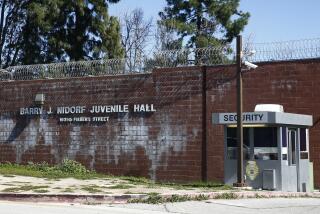Take a Chance on Hope : Youths: Any program--such as Hope in Youth--that is designed to contravene the killing of innocents is a bargain.
We’ve got our priorities mixed up.
While we’re still reeling from the social and physical devastation of the civil unrest in Los Angeles a few months ago, some actions by our elected officials suggest that the malaise afflicting a large portion of our city’s youth will continue to get worse.
It is undoubtedly the case that the fires and looting April 29 to May 3 were the product of human neglect. Our individual and collective disenfranchisement results from too many decades of complacency in the rearing and socialization of the city’s--and the nation’s--children and youth.
And so it is exceedingly distressing to hear that an innovative program that seeks to intervene in the lives of families at risk--at risk of having teen-agers who become alienated and those who band together in cliques referred to as gangs--cannot be promised funding from the City of Los Angeles.
Cardinal Mahony’s Hope in Youth project offers--at least potentially--a brighter future for our city and its citizenry. But the millions necessary to make a real difference in the lives of families that need intervention are compromised by spending priorities that seem more ready to build jail space and to put more armed officers on the street.
There’s something terribly wrong with a social and economic system that is unwilling or unable to take a chance on affirmatively slowing and reversing the deadly cycle of violence that plagues our inner cities.
Over the past decade, local, state and federal governments have experimented with the greatest prison-building program in the history of the country. The result of this program is, simply, more overcrowded jails and more felons waiting for bed space. Yet these same government entities are notably recalcitrant in developing and funding programs that deter our youth and young adults from the lives of crime that necessitate the jails in the first place.
Similarly, our priorities are grotesquely misplaced when we read that the Los Angeles Unified School District is forced to acquiesce to budget cuts in the amount of $400 million, and that the State of California seems ready to cut education funding by several hundred million dollars.
The primary venue for the positive socialization of our young adults--colleges and universities--are forced to shut their doors to tens of thousands of students while making sharp reductions in faculty and staff.
Because our government is of the people, by the people and for the people, we the people only have ourselves to blame for these misplaced budgetary priorities.
The lessons from the recent burning and looting of Los Angeles are all too grim: 51 deaths and $1 billion in damage. But even these statistics pale in comparison to the ravaging of our youth by drugs and gang warfare. Our city suffers several hundred homicides a year that are gang-related. This scenario is repeated in every major metropolitan area of the nation.
If we concede that every life is priceless, then a program that is designed to contravene in the senseless killing of young innocents must be a bargain at any price.
Although it is reasonable to ask that social programs demonstrate their effectiveness before funding, it is not reasonable to assume that such demonstrations of effectiveness can be accomplished in the absence of at least some funding. Even more substantively, social science research methods are notably incapable of demonstrating some effects. Perhaps a gang intervention program saves only one life. Although statistically insignificant, the saving of a single life is profoundly significant to the family involved.
We must be willing to take risks. We must be willing to commit the resources necessary to ensure a better present and future for our city. The Hope in Youth program seeks funding from the City of Los Angeles in the amount of $2.5 million. That’s less than $1 per person per year. Surely we can afford that and more if it has the potential to stem the tide of crime and violence that costs far more in its human and material devastation.
We must get our priorities in order. Education and social welfare must be placed at the top of our agenda. Once these issues are considered primary, there should be little debate about experimenting with programs that ensure their well-being.
More to Read
Sign up for Essential California
The most important California stories and recommendations in your inbox every morning.
You may occasionally receive promotional content from the Los Angeles Times.










